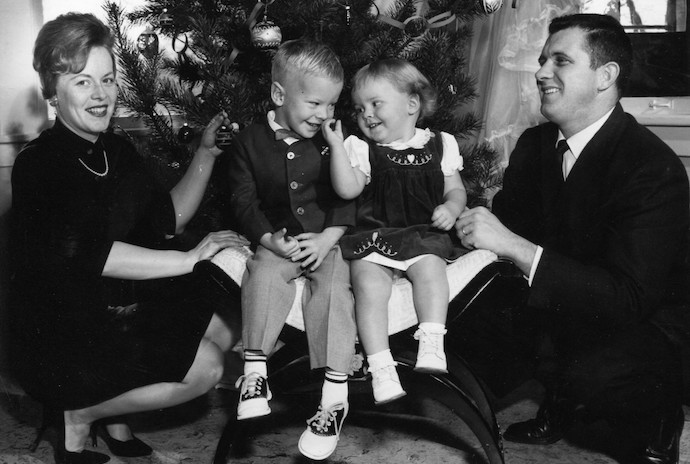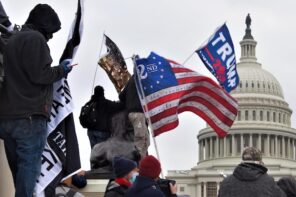Robert Jones, founder of the Public Religion Research Institute, has been doing the op-ed thing recently to publicize his new book: White Too Long: The Legacy of White Supremacy in American Christianity. Jones articulates a thesis that’s sure to make many a member of the pew-ballast class squirm:
[W]e white Christians have not just been complacent or complicit; rather, as the nation’s dominant cultural power, we have constructed and sustained a project of perpetuating white supremacy that has framed the entire American story. The legacy of this unholy union still lives in the DNA of white Christianity today — and not just among white evangelical Protestants in the South, but also among white mainline Protestants in the Midwest and white Catholics in the Northeast.
You can bet that Jones—one of the best pollsters of American religion at work today—has the data to back his argument up. White Christians, as he notes, are much more likely than the average citizen to buy the “heritage not hate” shtick about Confederate monuments, and much less likely to agree that the repercussions of slavery and institutionalized racism make it difficult for Blacks to find economic success in the U.S. Importantly, Jones didn’t just ask straightforward questions about race, but found indirect ways to test for perceptions about structural racism. This is what you would want in a sensitive exploration of a complex topic. And other researchers see corresponding trends in their own datasets.
It’s unlikely that anyone who has studied the subject for more than the time it takes to read a few Wikipedia articles will be shocked to hear that American Christianity is part and parcel of a white supremacist social order. American society is racist, the church is part of the society, ergo, the church has problems with race. (White Christians are the trespassers, of course, but their sin distorts the entire body of Christ.)
What will be more difficult for a lot of folks to hear is that racism isn’t a bug in the system, it’s a feature. Or to put things more theologically, if racism is America’s original sin, guess who Adam and Eve are? As Jones puts it:
When confronted with unsettling results such as these, many of my fellow white Christians tend to explain them away with two objections. First, they assert that it is not white Christian identity itself but other intervening variables that account for such correlations. Second, they argue that even if white Christian identity is implicated, the results are muddied by the inclusion of people who have no real connection to actual churches, folks who are “Christian in name only.“
But as Jones drily notes, “even when controls are introduced in a statistical model for a range of demographic characteristics, such as partisanship, education levels and region, the connection between holding racist attitudes and white Christian identity remains stubbornly robust.” So it’s not accidental, nor is it incidental, that white Christians are more racist than their non-religious peers. In fact, the more often white Christians attend church, the more likely they are to hold strong white supremacist views. And again, it’s not just evangelicals: Catholics and mainline Protestants show the same pattern.
I’m not quite ready to embrace the idea that there’s something inherent in white American Christianity that produces and reproduces a white supremacist perspective, but that’s sure what it looks like from Jones’ data. He’s quite right to point out the long entanglement of the white church with racist social norms, and right that that entanglement has never been fully reckoned with, even in the most progressive denominations. In that sense, his book may serve as a welcome call to repentance to Christians who think their church is doing better on racial issues than it really is.
But will White Too Long be able to provoke change on a broader, more systemic level? I’m less sure of that.
Obviously, there aren’t too many white churches where people sit around on Sunday morning talking about ways to do a racism in the coming week. There are explicitly white supremacist leaders and communities, but they are blessedly few and far between. What’s more of a problem are the “partially self-transcendent” Christians, in Niebuhr’s terms. Those are the people who can see beyond their own limitations—a bit. They can understand that they’re not perfect on racial issues, and may even have a good handle on where to start in addressing them.
But whites cannot see for themselves all the ways they’ve bought into or benefit from systemic injustice, nor can they see on their own all their own failings and sins. Some are more ignorant than others, of course, but everyone has a least a few blind spots. In other words, perhaps what causes white Christians in America to hold racist views is their limited capacity for self-critique. If they understood how they were a part of the problem, they could repent their sins and work to extricate themselves from them. Hence the need for a book like Jones’: the truth can’t set you free until you know what the truth is, and the truth is that white American Christians suck at racial equality.
It’s a decent hypothesis and response, but simply knowing better rarely solves issues as complex as white supremacy. Social problems are, well, social, and require us to take into account broader patterns and movements. In this instance, it’s worth looking at another trend Robert Jones has chronicled: the decline of American Christianity. Religious adherence and worship attendance in postwar America peaked in the mid-1960s, just at the same time that contemporary racial views began to coalesce. It’s possible, then, that white Christians are more accepting of white supremacist views than the religiously affiliated because the people who don’t accept those views have steadily left the church, as have those who are more open to the queer community, or to science, or really, just liberalism on many scores. To put it another way, today’s “Nones” might have been the loosely-affiliated white Christians of fifty years ago, balancing at least nominally those more invested in the social order.
I can say as a matter of practical experience that as white American Christianity contracts, the people left behind in the pews are indeed those most committed to preserving the social order. Keeping tradition alive is exactly why they’re there Sunday after Sunday. If you’d served in some of the places I have, such as a small town in northeast Pennsylvania coal country that’s less than half the size it was in 1960, as the young move away for employment and some kind of future, you’d understand why that’s not entirely a bad thing. Keeping the church alive might be the only thing between some people and the bottom falling out of their society. But if you know the politics of that same area, you know how dark the shadow side of that same instinct can be. When “the way things used to be” involves poisonous racial resentment, the desire to preserve tradition becomes corrupted. Traditionalism isn’t in itself bad, but it can promote social rigidity just by bringing together people like-minded in their stubbornness; at worst, it can lead to radicalization.
In fact, radicalization seems to be the bigger picture of white Christianity, and white America in general, over the last few decades. Those willing to let go of tradition in favor of something more cosmopolitan and egalitarian have by and large done so, though the transition isn’t complete. Then there are a few fools like me who think there’s something worth redeeming in the old ways of life, but mostly, it’s down to the people unable or unwilling to embrace the way American society has changed. Those are increasingly preyed upon by people willing to partisanize religious identity, which is why conservatives love to say things like liberals want to “attack and dethrone God.” Of course, partisanization and racialization are often one and the same these days, which is why you have people all the way from James Dobson to Andrew Sullivan declaring that the Black Lives Matter movement and the protests it’s sparked are “incompatible with Christianity.” (Fact check: wrong.)
This train of thought seems to be taking us into an ever-darker tunnel. Jones’ underlying theory is apparently that if white Christians knew what they were doing was wrong, they would self-correct. I’m suggesting that the people most capable of self-correction may have already left the institution of the white church, that those who remain may not be willing or able to change, and that outright racists may be taking advantage of the situation for their own ends.
So can white Christian America be saved? I’m afraid I have to answer that with a question of my own: it depends. Why do you want to save it?
If the point is that the white church is better than its sins of racism, and is worth saving in itself, the answer is probably “no.” It’s up to God, of course, but careful study and prayer and discernment simply aren’t going to change enough hearts and minds to bring the white church back to the kind of moral authority it used to have. America seems to be at an incredibly difficult intersection in its social life these days. Trump has brought to a boil long-simmering divisions between conservative whites, particularly in exurban and rural areas, and the emerging knowledge economy of the cities and suburbs.
The Christian church, as always, neither completely drives these changes, nor is completely at their mercy. Rather, like any religious institution, it intersects them in difficult and ambiguous ways. As much as Christians would like to proclaim God’s sovereign majesty leading the unchanging gospel through the darkness of a fallen world, the truth is, the church, like any human institution, changes and adapts to present circumstances, sometimes better than others. Given the magnitude of the changes being currently experienced in American society, the best hope for white American Christianity might be to just leave it all behind, and wait to see what new thing God will bring about in its place.





